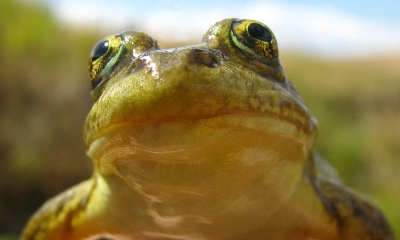
Amphibians
Amphibians are cold-blooded animals - frogs, toads, salamanders and newts - that live throughout the state.
Types of Amphibians

Salamanders are a group of tailed amphibians with long bodies and short limbs. They often prefer habitats with damp conditions, which allows them to “breathe” better through their skin. Wet and rainy days (typically late fall through spring in Oregon) are the best time to look for salamanders, as the additional moisture from fog and rain allow for increased surface activity.
To find salamanders, look in cracks or search under bark, rocks or logs. If you move any debris during your search, remember to put it back where you found it when you’re done—salamanders are sensitive to disturbance and many salamanders are also protected in Oregon (protected: “unlawful for any person to take, capture, hold, release or have in possession, either dead or alive, whole or in part”).
Oregon’s 19 species of salamanders can be grouped into four different families. The mole salamanders (Family: Ambystomatidae, Genera: Amystoma and Dicampyodon) are some of Oregon’s largest native amphibians; adults can be either aquatic or terrestrial, and larvae are aquatic with long gills.
The single newt in Oregon (Family: Salamandridae, Genus: Taricha), is also an aquatic breeder with a terrestrial adult stage. It can be distinguished from other salamanders by its rough skin and brightly-colored belly. While not all salamanders are newts, all newts are salamanders!
Torrent salamanders (Family: Rhyacotritonidae, Genus: Rhyacotriton) are medium-sized, semiaquatic salamanders with noticeably short snouts. Adults and larvae are often found in cold and rocky forest streams. Males are easily identified by the uniquely-shaped rectangular vent glands.
Plethodontids are the most diverse type of salamander in Oregon (Family: Plethodontidae, Genera: Plethodon, Ensatina, Aneides, and Batrachoseps). These lungless terrestrial salamanders can be distinguished from other salamanders by the presence of a slit from the upper lip to the nostril (called the nasolabial groove). Compared to other salamanders in Oregon, Plethodon and Batrachoseps salamanders are rather small with long bodies and short limbs.

Worldwide, frogs and toads are in trouble because of habitat loss, pollution, pesticides, climate change, diseases, the pet trade and competition from invasive species. Many of Oregon's 12 native species of frogs and toads are listed as Oregon Conservation Strategy Species of concern.
Frogs and toads belong to the same animal group but are very different. Toads have dry, rough and bumpy skin covering a wide body while frogs are slender with smooth, moist skin. Frog eyes are higher on the head than toads and are rounder and bulging. And there's a reason we play "leap frog" - frogs take long, high jumps but toads run or take small hops.
Check out our fun fact sheet on Oregon's frogs and toads.

